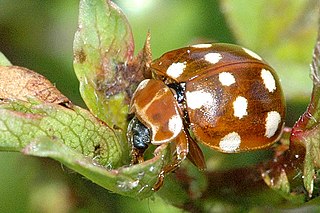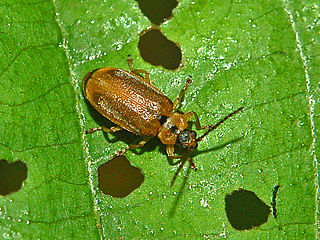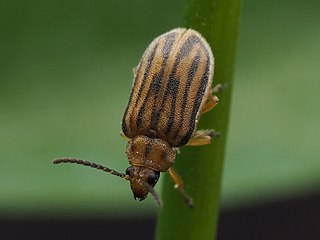
The insects of the beetle family Chrysomelidae are commonly known as leaf beetles, and include over 37,000 species in more than 2,500 genera, making up one of the largest and most commonly encountered of all beetle families. Numerous subfamilies are recognized, but the precise taxonomy and systematics are likely to change with ongoing research.

Sphaerius is a genus of beetles, comprising 23 species, which are the only living members of the family Sphaeriusidae. They are typically found along the edges of streams and rivers, where they feed on algae; they occur on all continents except Antarctica. Three species occur in the United States.

Darkling beetle is the common name of the large family of beetles Tenebrionidae. The number of species in the Tenebrionidae is estimated at more than 20,000 and the family is cosmopolitan in distribution.

Ulmus changiiW. C. Cheng, occasionally known as the Hangzhou elm, is a small deciduous tree found across much of China in forests at elevations of up to 1800 m. Owing to its increasing scarcity, U. changii was added to the Hainan Province Protected Plants List in 2006.
Ulmus pseudopropinquaWang & Li, occasionally known in the United States as the Harbin spring elm, is a small deciduous tree found only in Heilongjiang, the northeasternmost province in China. The tree has not been studied comprehensively, and it has been speculated it may be a natural hybrid of Ulmus davidiana var. japonica and Ulmus macrocarpa.

The American elm cultivar Ulmus americana 'Lewis & Clark' is a development from the North Dakota State University (NDSU) Research Foundation breeding programme, released in 2004 to commemorate the 200th anniversary of the eponymous expedition. The cultivar was cloned from a tree discovered in 1994 along the Wild Rice River south west of Fargo, ND., where all those around it had succumbed to Dutch elm disease; the tree remains in perfect health (2008). Prairie Expedition proved only moderately successful in the US National Elm Trial, averaging a survival rate of 62.6% overall, owing largely to environmental factors rather than susceptibility to Dutch elm disease.

The Synetinae are a small subfamily within the leaf beetle family (Chrysomelidae). They are found entirely within the Holarctic, mainly in North America but also appearing in parts of Europe and Asia. The subfamily contains only two genera, Syneta and Thricolema, with a total of 12 described species. The group is sometimes treated as a tribe of Eumolpinae, where they are known as Synetini.
The American Elm cultivar Ulmus americana 'St. Croix' is a recent (2008) selection cloned from a large tree growing at Afton, Minnesota, which has displayed a high resistance to Dutch elm disease (DED). A U S patent, PP 20097, was granted in 2009.

The cream-spot ladybird is a species of ladybird in the family Coccinellidae. Its distribution is holarctic, it being found in Europe and through the East Palearctic to Japan. It is introduced to North America. This ladybird is generally 4 to 5 millimetres in length and varies in appearance depending on the geographical location. It usually lives in hedgerows and deciduous trees.
Syneta adamsi is a species of beetles from the family of leaf beetles, subfamily Synetinae.
Thricolema is a genus of leaf beetles in the subfamily Synetinae. It contains only one species, Thricolema anomala, known from California and Oregon in the United States. Thricolema resembles Syneta, except that the adult females of Thricolema have simple tarsal claws, whereas adults of both sexes of Syneta have bifid claws. The body of an adult is elongated and fibrous. Adults are associated with Calocedrus decurrens.
Syneta albida, the western fruit beetle, is a species of beetles from the family of leaf beetles, subfamily Synetinae.

Syneta is a genus of leaf beetles in the subfamily Synetinae. There are about 11 described species in Syneta. The genus is entirely holarctic in distribution, with species appearing in North America, Siberia, East Asia and Northern Europe.

Galerucella is a genus of leaf beetles in the family Chrysomelidae described by George Robert Crotch in 1873. It is widely distributed but absent in the Neotropics.Some species feed on waterlilies and are used as biocontrol of introduced, invasive waterlilies. Galerucella tenella feed on strawberry plants.

Ophraella communa, common name ragweed leaf beetle, is a species of beetles belonging to the family Chrysomelidae.
Syneta carinata is a species of leaf beetle. It is found in northwestern North America. The specific name was first used by Johann Friedrich von Eschscholtz in his collection before 1831, but was never published by him. Instead, the name is attributed to Carl Gustaf Mannerheim, who published a description of the species in 1843.
Syneta extorris is a species of leaf beetle. It is found in eastern North America.
Syneta hamata is a species of leaf beetle. It is found in western North America.
Syneta simplex is a species of leaf beetle found in North America. The species includes the two subspecies Syneta simplex simplex, which lives at elevations considerably below timberline and feeds on Garry oak, and Syneta simplex subalpina, which is found near timberline in Washington and British Columbia and feeds on alpine fir.
Syneta pilosa is a species of leaf beetle. It is found in North America.









